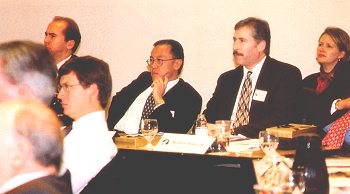The industry crossroads referred to in Part 1 of this report on Jones Lang Wootton’s Corporate Real Estate Leadership Forum was brought sharply into focus during the final two sessions of the day-long event. The meeting, which had a “Focus on Innovation” theme, was held at IBM’s world headquarters facility in Armonk, N.Y., on Nov. 19, 1998. The crossroads is the intersection of the way the corporate real estate (CRE) profession has been defined, particularly in terms of how CRE practitioners relate to other departments, and the new direction in which the industry is headed.
The latter looks less like the corporate real estate profession familiar to the veterans of the industry than some of them might like. But the corporate real estate function must do three things well on the road ahead that were only marginally important in the past.
First, it must evolve philosophically with the rest of the organization, meaning its vision must match or enhance the core business’s vision of the future.
Second, it must provide insightful solutions to senior management’s strategic issues – not just supply extra floor space when a department expands.
 And third, it must learn to walk the fine line between providing tangible, meaningful shareholder value, which means having a broad financial skill set, and providing innovative work space, human resources and even systems-based solutions to issues that could hinder the company’s ability to meet its strategic objectives. The point of the third mandate is to integrate business unit strategies with the demands of the capital markets, explained Sandra Lambert (left) of Massachusetts Institute of Technology’s Center for Real Estate (CHK). Lambert co-moderated a session on capital investment decisions that actively incorporate finance, human resources, technology and work place strategies.
And third, it must learn to walk the fine line between providing tangible, meaningful shareholder value, which means having a broad financial skill set, and providing innovative work space, human resources and even systems-based solutions to issues that could hinder the company’s ability to meet its strategic objectives. The point of the third mandate is to integrate business unit strategies with the demands of the capital markets, explained Sandra Lambert (left) of Massachusetts Institute of Technology’s Center for Real Estate (CHK). Lambert co-moderated a session on capital investment decisions that actively incorporate finance, human resources, technology and work place strategies.
Not all that long ago, said Lambert, information technology and human resources represented limitations rather than solutions to business strategies. Corporate real estate’s role in the organization was in flux and resources from other core business functions were often less than adequate.
Winds of Change
“Real estate is much better understood today as a strategic support to the corporation than it was just a few years ago,” Lambert noted. “The constraints are no longer the resources themselves. They are a question of how one leverages those resources, according to our research.” As corporations target growth (with financial analysts watching closely), they must also “precipitate change in their efficiency goals, their knowledge transfer goals, responsiveness-to-customer goals and so on in the global markets,” she added. “This, in turn, changes decisions that are made in terms of business unit level and corporate level lifecycle choices and lifecycle implications of decisions related to acquisition and consolidation, which in turn has an impact on organizational design.” All of which points to an ongoing challenge to adapt and readapt real estate portfolios.
More challenging still, Lambert reminded the participants, is the mandate to manage the portfolio in harmony with other strategic business functions within the context of the capital decision making process.
“Finance is involved earlier and certainly more fully in capital budgeting decisions regarding fixed assets, like real estate,” confirmed Robert Dmytryk, a Jones Lang Wootton director, corporate and advisory services, in Los Angeles, who co-moderated the session with Sandra Lambert. “A second trend to point out, and IBM’s Lee Dayton alluded to this earlier, is that off-balance sheet [financing] is the goal as long as you don’t adversely impact cash flow.” Dmytryk then walked attendees through a detailed, hypothetical capital allocation exercise to illustrate the importance of financial management forces in blending business strategy with shareholder value.
Another exercise during this session involved small groups of corporate real estate executives discussing how key business objectives are impacted by corporate real estate initiatives. The six business objectives used in the exercise were identified in previous research done at MIT by Lambert and others in conjunction with the International Development Research Council, the leading association of corporate real estate executives. The business objectives are business continuity; customer access and satisfaction; employee access, retention and satisfaction; economic value; operating efficiency; and productivity. “These goals are significantly affected by location decision making and workplace design,” Lambert emphasized.
What did the discussion groups discover? “Operating efficiency is very important to our group, meaning cost savings,” reported one group’s representative. “Benchmarking was identified as important, as were various metrics.” The group also listed flexibility of space, churn, exit strategies and the inevitability of change.
“We spent most of the time talking about employee retention and productivity, the latter in the context of a co-location case,” noted another group’s spokesman. “The economic reasons for doing a co-location fell apart for cultural reasons.”
Another group was concerned most with employee access, retention and satisfaction. Members sought better demographic analysis to locate richer labor supplies, closer ties to the human resources department to understand what attracts the workers desired, and insights into what competitors are doing to address the same issues.
“We thought flexibility was absolutely critical,” reported a fourth group’s representative, “particularly in terms of adapting to information technology changes.”
Economic value, cost savings and operating efficiency were another group’s key areas, as was the importance of having information relating to transportation infrastructure and macro-economic development initiatives in critical locations.
“The implication of this exercise and the original research is not that any particular strategy creates value, but simply that there is a relationship between the workplace design decision, the location decisions and these objectives,” Lambert related. “The customer access and business continuity objectives were raised when we began to ask what is different when the CRE unit is handling real estate globally?” she added. “Those objectives became much more significant issues when they were handling an international portfolio.”
What to Pay the Piper?
 The day’s final session was a poignant one for the event organizer, Jones Lang Wootton. The topic was aligning service providers’ interests with client objectives and performance-based compensation plans. Session facilitators were JLW’s Mark McLaughlin and Debra Moritz, senior director and director respectively in JLW’s corporate and advisory services unit.
The day’s final session was a poignant one for the event organizer, Jones Lang Wootton. The topic was aligning service providers’ interests with client objectives and performance-based compensation plans. Session facilitators were JLW’s Mark McLaughlin and Debra Moritz, senior director and director respectively in JLW’s corporate and advisory services unit.
“The hottest topic today among real estate professionals is, in fact, how service providers are paid in today’s business [environment],” noted Debra Moritz, citing a recent industry survey. “We’re seeing additional services and higher quality services demanded by CRE professionals. Some are less tangible than the historical operational services,” she added. These include helping clients draft new performance metrics, realign the real estate department and other nontraditional services.
“Traditionally, people would look for a transaction provider to be paid on a commission basis, and other services might be thrown in for free,” Moritz continued. “Corporations recognize that getting that extra value is worth a dollar, and now there seems to be a more direct correlation between services provided and the fees actually earned.” The advisory or the traditional real estate brokerage approach to providing services is now moving in the direction of a management consulting approach with fees moving away from the commission-only structure to a fee-only or fee-plus-commission structure.
Based on survey findings and other resources relating to performance measurement tools used in the industry, “We have developed some ways the business unit is perceived to be measured and the service provider is perceived to be measured,” McLaughlin related. “Now, the challenge is how to transition that to using compensation to enhance or improve different measurements. It’s an art and a science. The art is where we like to use compensation as a way to enhance performance. The science is how do we actually do that so that it’s fair and reasonable and does not create workload?”
Participants from the CRE side of the discussion continue to wrestle with such tasks as valuing services prior to contracting with providers for them, how to measure performance in performance-based compensation situations, and accessing departmental or corporate funds with which to hire consultants when they feel the need for outside expertise. Another concern is resolving these issues as the pendulum swings from an unbundled service delivery model to a bundled service model, where multiple services are provided under one contract. Still more vexing to some in the group is their superiors’ “aversion to cutting a check for a real estate service provider.” The message, they feel, is that in-house CRE personnel should be capable of handling any issue in the real estate domain.
But for CRE professionals to achieve what they must, as outlined in the three points raised at the beginning of this report, they necessarily will have to draw on resources near and far. Do the business units with whom the CRE is working help fund access to these resources? Fee and commission-sharing arrangements are becoming the norm at many companies, but the issue is ripe for further analysis.
Two points are clear where the service provider-client relationship is concerned. Performance measures will emerge from leading thinkers in the industry, and they will govern more and more such relationships in the years ahead. Secondly, corporate real estate executives will approach service provider arrangements from a greater position of power than they do today; they will, in fact, drive such relationships. Besides knowing their way around a lease contract, most CRE professionals within a few years will be financial management experts with an eye for adding shareholder value wherever possible. They’ll either see that ability in their service providers’ eye, as well, and agree to pay fairly for the service, or they won’t.
SS
